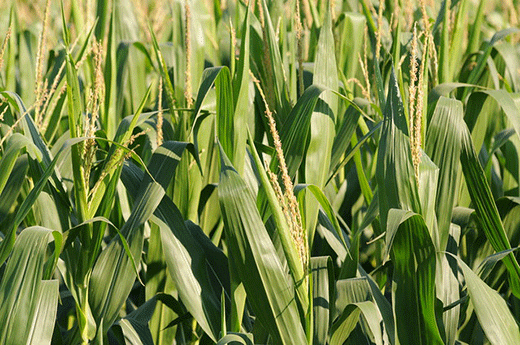
The incidence of disease in Kansas corn currently seems to be very low, says K-State row crop specialist Doug Jardine. | Download this photo
Disease threat currently low in Kansas corn fields
But K-State’s Jardine says growers should remain vigilant
July 3, 2019
MANHATTAN, Kan. – A Kansas State University row crop specialist says he’s happy – even if surprised – by the low incidence of disease he’s finding in the state’s corn fields so far this summer.
But he’s urging growers to continue scouting their fields for diseases that have been commonly found in Kansas in past years.
“I have been surprised by the low levels of gray leaf spot in most fields,” said Doug Jardine, who has traveled several areas of Kansas over the past few weeks looking at corn and soybean fields.
“In those areas where I was able to find gray leaf spot, it was on the very lowest leaves, even in some fields that I know have had a problem with a history of this disease.”
Gray leaf spot is a fungus that causes an estimated loss of 9 million bushels of corn per year in Kansas. It was first found in the state in 1989, and is considered the most serious foliar disease of corn in Kansas and the north central United States.
For that reason, indications that it might not be as prevalent so far this summer is no reason for growers to become complacent.
“It’s present in the state, so we need to be scouting,” Jardine said. “But at this point, I was not personally in any fields that I think are going to need a fungicide this year. And given the commodity prices this year, if we can save $15 to $25, that’s probably a good thing.”
He added that the lower incidence of the disease in Kansas could be due to growers’ tendency in recent years to plant hybrids containing tolerance to gray leaf spot, “because that’s what we’ve preached as the primary management practice for years.”
Jardine said that gray leaf spot is sometimes confused with another disease that shows up routinely in Kansas – bacterial leaf streak, a bacteria that is more common in corn fields managed under continuous no-till and center pivot irrigation.
He noted that bacterial leaf streak is mostly found in the western one-third of Kansas, but has been found recently in the southeast (Labette County), north central (Clay County) and south central (Butler County) parts of the state.
“To an untrained eye, this disease can look very similar to gray leaf spot,” Jardine said. “We know over the last 3-4 years that people thought they had gray leaf spot, went out and sprayed and saw no response to the fungicide application – that’s because fungicides don’t work on bacteria.”
Differences between the two diseases are often seen in the lesions that appear on the leaves of the corn plant.
“With gray leaf spot, the lesions are defined by the vein, so they have very sharp borders on them; they don’t cross the vein,” Jardine said. “With bacterial leaf streak, they don’t respect that vein, so they can have a wavy edge that crosses the border and comes back. They tend to be very long and linear.”
He noted that another test is to hold up an infected leaf so that it is back-lit by the sun. If the light passes through readily (translucent), the disease is likely to be bacterial leaf streak. But if light doesn’t pass through the lesions (opaque) and appears dark brown, the disease is likely to be gray leaf spot.
In either case, Jardine suggests that growers submit samples of suspect leaves through their local extension office, or send directly to the plant disease diagnostic lab at Kansas State University.
In addition, Jardine said corn growers should be on the lookout for signs of the root lesion nematode, which were “very severe” in northeast Kansas (Doniphan and Brown counties) a year ago.
Producers who suspect an infestation of root lesion nematodes should dig up whole plants 30-40 days past emergence, shake off the excess soil from roots, and send the sample into the plant disease diagnostic lab.
Jardine said one sample received at K-State a year ago had a count of 100,000 nematodes per gram of root weight. That’s a huge number considering that yield losses in corn are common with infestations of 5,000 to 10,000 nematodes per gram of root weight.
“You’re looking for stunted areas in the fields, especially if they’re starting to become a little chlorotic (yellowish),” Jardine said.
Specific to soybeans, Jardine said he’s keeping his eye out for the presence of frogeye leaf spot, which could take hold in some fields this year because of the wet June weather in Kansas.
More information on crop diseases in Kansas is available from K-State’s Department of Plant Pathology, and the weekly e-Update published by the Department of Agronomy.

